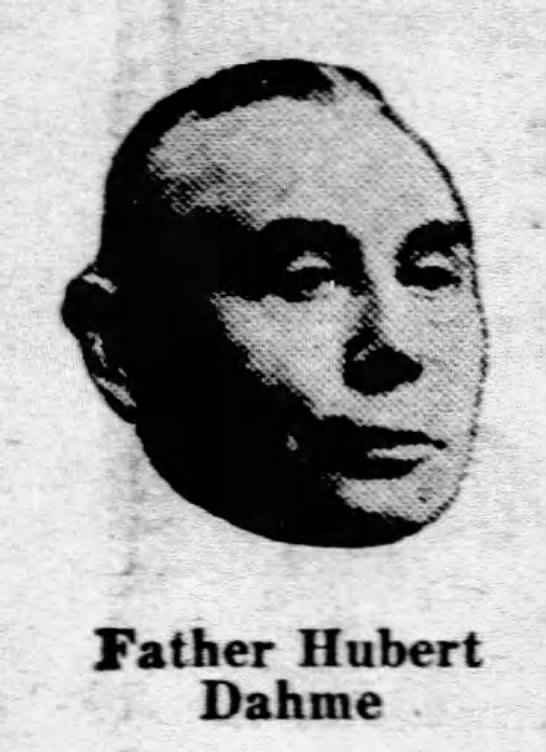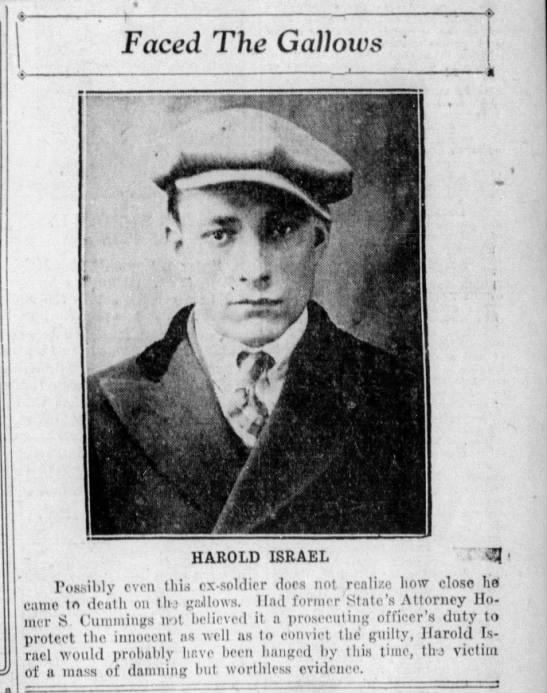 |
| "New York Daily News," February 16, 1924, via Newspapers.com |
The Reverend Hubert Dahme was one of the most respected and well-liked men in Bridgeport, Connecticut. The elderly Catholic priest was known as kindly, helpful, and sincerely, yet humbly, religious. In short, he appeared to be the last person in the world that anyone would like to see dead.
If you are an old-timer around this blog, you will not be shocked by what comes next.
At about 7:45 p.m. on February 4, 1924, Dahme was walking down Bridgeport's Main Street. Some witnesses stated that he was walking alone, others that he seemed to be accompanied by another man. Whether the man was with Dahme or not, he suddenly turned, and, without a word, shot the priest dead. The assassin then swiftly disappeared into the darkness. Later, no one was able to clearly describe the man, and they did not claim to recognize him. All they could say was that he was comparatively young, of medium height, and wearing a gray cap and an overcoat with a velvet collar. (It should be noted that other people in the area at the time reported seeing two men fleeing the scene.)
This was one of those cases where the investigators did not have the slightest idea even where to begin. Dahme had no enemies. No one was known to even have a discernible reason to feel any hostility to him. Lacking any idea who the killer might of been, or any possible motive for the crime, the police were at a standstill.
Eight days after the murder, 28-year-old Harold Israel was arrested for vagrancy in nearby Norwalk. For months past, the young man had had no occupation other than heavy drinking. When the police realized that the gun he carried was the same caliber that had killed Dahme, they immediately treated him as their top--only, really--suspect. At first, Israel claimed his innocence, but after over 28 hours hours of intense interrogation, he gave in, offering a long, pitiful confession. He explained that on the day of the murder, he was broke, starving, and increasingly desperate about his inability to find work. While wandering aimlessly through the town, something snapped inside him. Out of sheer fury with the world, he pulled his revolver from his pocket and wildly fired at the first person he saw--who was, very unfortunately for the priest, Hubert Dahme. Nellie Trafton, a waitress at a luncheonette near the murder scene, provided some corroboration for this story by stating that shortly before Dahme was killed, she had seen Israel--whom she knew--walking past her shop. Four witnesses to the shooting identified Israel as the killer. A police ballistics expert said that the bullet which killed Dahme came from Israel's gun.
A very sad case, but at least one that was finally solved.
Or was it?
The State Attorney, Homer Cummings, wasn't too sure about that. If Israel was, as he said in his confession, crazed with hunger when he shot Dahme, why didn't he pawn his gun to buy food? If he just randomly shot the first person he saw, why was Dahme shot in the back of the head, not the front? Cummings interviewed Israel himself, bringing up the discrepancies in his story. Israel wound up retracting his confession. He said that under the harsh, lengthy questioning by the police, he found himself willing to tell them anything if they would just leave him alone. He told Cummings that he had really been in a movie theater at the time of the murder.
But what of the eyewitness testimony? One evening, Cummings went to the waitress' restaurant and asked her to show where she had been standing when she saw Israel walk by. When Cummings himself stood in the spot she indicated, he saw that the steam from the restaurant, plus the reflection of the bright lights outside, made it very difficult to see clearly through the glass. When he then walked on the street past the restaurant, the waitress was unable to recognize him. She finally admitted that she had simply invented her entire story, in the hope of claiming the reward that had been offered to anyone who could identify the killer. He tested the witnesses who had identified Israel as the killer by standing in the same places where they had been at the time, and with similar lighting conditions. He had one of his deputies flee the scene in the same way the killer had done. He realized that in the dim light, it was virtually impossible for those people to know who was going by. In the same circumstances, Cummings had been unable to identify his own deputy! After questioning the owner and employees of the movie theater that Israel claimed to have attended, Cummings believed the accused man was telling the truth about his alibi.
Cummings brought in six ballistics experts to do tests on Israel's gun. They all concluded that the defendant's gun fired bullets with distinctive markings that in no way matched the bullet that killed Dahme.
All this was enough for Cummings to tell the court that he was dropping the case against Israel. The young man was freed. The one good thing to be said about this story is that the unnerving experience of being very nearly convicted of murder shocked Israel into pulling his life together. He stopped drinking, got married, and eventually became a successful merchant.
 |
| Hartford Courant, April 19, 1925 |
One can hope that Father Dahme’s ghost was able to take some pleasure in this pleasant plot twist, because his spirit never had the satisfaction of seeing his killer brought to justice. The priest's murder remains a mystery.
[Note: The Dahme case was the inspiration for Elia Kazan's 1947 film "Boomerang."]

I recently saw "Boomerang", and am pleased at how close the movie was to real-life. But then, when you have a real-life story like this, why embellish it? And I think that, if Father Dahmen was the Christian soul he seems to have been, he would have been more satisfied with Israel's recovery than with his killer being found.
ReplyDeleteIt's unlikely that the killer was walking with Dahme because he would then have had to get behind him to shoot him in the back of the head. The witnesses who thought they were together probably just saw the killer moving up behind him or moving past him after firing the shot.
ReplyDeleteThe ruthless efficiency with which the crime was committed suggests a professional hit-man. But Cummings' investigation showed how difficult it could be to identify people at that location on a dark winter evening, and if the murderer approached Dahme from behind he probably didn't see his face clearly. So, it looks like a case of mistaken identity.
Also, the excerpt from the "Hartford Courant" describes Israel as an "ex-soldier". If he fought in WWI then his drinking might have been due to what we'd now call PTSD.
After reading many shoddy police investigations on this blog where innocent people were "railroaded", it is refreshing to see a police officer actually test for himself the evidence.
ReplyDelete